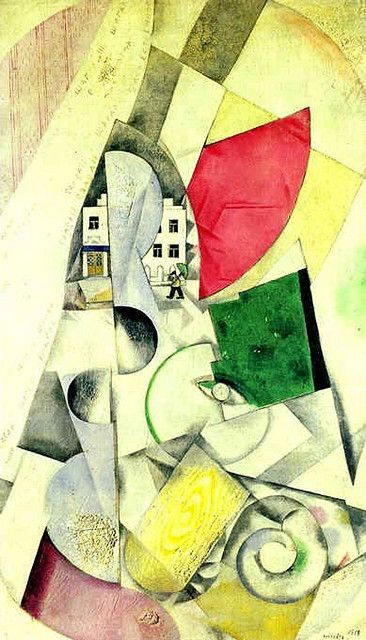log in
Enter site
Login to use Arthive functionality to the maximum
Cubist landscape
Marc Chagall • Painting, 1918, 100×59 cm
Description of the artwork «Cubist landscape»
After the February Revolution, Chagall was offered to join the Ministry of Art. Undoubtedly, such a proposal was flattering for the artist. Bella's revolutionary moods of her husband were incomprehensible, she wanted a quiet life for herself and baby Ida. Chagall allowed himself to be persuaded, and the family left for Vitebsk.
In 1918, Lunacharsky summoned Marc Chagall to Moscow. "Is it my job to describe how our muscles tensed during these years? The flesh turned into paint, the body turned into a brush, the head turned into a tower. I wore wide trousers and a yellow boot ... I went to meetings like everyone else" - this is how I recalled Marc Chagall post-revolutionary period. Lunacharsky offered the artist to take the post of Commissioner for Arts in the Vitebsk province, and Chagall agreed. He became more and more disillusioned with the revolutionary spirit of his brush colleagues, but the idea of creating a People's Art School in Vitebsk attracted him very much.
During this period, Chagall created large-format design works that adorn the streets and squares of revolutionary Vitebsk - for example, sketches for a panel"War to the palaces" and "Forward, forward without stopping." But in parallel, he writes his best and famous works, the main theme of which is their love union in Bella: "Stroll", "Above the city", "Wedding. Wedding".
Chagall usually used the techniques of contemporary styles, never adhering to their clear postulates. This also applied to Fauvism, which he met during his first visit to Paris, and later to surrealism, elements of which he introduced into his paintings in the 1920s. Against the background of all the works of 1918, the painting "Cubist Landscape" stands apart, representing a clear adherence to the style. Perhaps it was created at a time when Chagall was thinking about candidates for the role of future teachers of his People's Art School, including Kazimir Malevich.
By that time, Malevich was already actively developing his theory of Suprematism. Like Chagall, like many supporters of new trends and styles, Kazimir Malevich equated the revolution in the country and the revolution in art. But, as it turned out later, each of them had their own understanding of the degree of "revolutionary". Arriving in Vitebsk, Malevich, already an accomplished artist with his clear program and vision of contemporary art, quickly overtook almost the entire school. Just six months later, he founded UNOVIS ("Hardeners of the New Art"). Malevich taught Suprematism. Chagall taught to draw. But Malevich knew how to convince, and his revolutionary ideas for the development of art pushed Chagall to the background.
In the summer of 1920, Kazimir Malevich and his students went to an exhibition in Moscow. And on the same train Marc Chagall left Vitebsk: the battle for his dream, for his Art School, was lost.
In 1918, Lunacharsky summoned Marc Chagall to Moscow. "Is it my job to describe how our muscles tensed during these years? The flesh turned into paint, the body turned into a brush, the head turned into a tower. I wore wide trousers and a yellow boot ... I went to meetings like everyone else" - this is how I recalled Marc Chagall post-revolutionary period. Lunacharsky offered the artist to take the post of Commissioner for Arts in the Vitebsk province, and Chagall agreed. He became more and more disillusioned with the revolutionary spirit of his brush colleagues, but the idea of creating a People's Art School in Vitebsk attracted him very much.
During this period, Chagall created large-format design works that adorn the streets and squares of revolutionary Vitebsk - for example, sketches for a panel"War to the palaces" and "Forward, forward without stopping." But in parallel, he writes his best and famous works, the main theme of which is their love union in Bella: "Stroll", "Above the city", "Wedding. Wedding".
Chagall usually used the techniques of contemporary styles, never adhering to their clear postulates. This also applied to Fauvism, which he met during his first visit to Paris, and later to surrealism, elements of which he introduced into his paintings in the 1920s. Against the background of all the works of 1918, the painting "Cubist Landscape" stands apart, representing a clear adherence to the style. Perhaps it was created at a time when Chagall was thinking about candidates for the role of future teachers of his People's Art School, including Kazimir Malevich.
By that time, Malevich was already actively developing his theory of Suprematism. Like Chagall, like many supporters of new trends and styles, Kazimir Malevich equated the revolution in the country and the revolution in art. But, as it turned out later, each of them had their own understanding of the degree of "revolutionary". Arriving in Vitebsk, Malevich, already an accomplished artist with his clear program and vision of contemporary art, quickly overtook almost the entire school. Just six months later, he founded UNOVIS ("Hardeners of the New Art"). Malevich taught Suprematism. Chagall taught to draw. But Malevich knew how to convince, and his revolutionary ideas for the development of art pushed Chagall to the background.
In the summer of 1920, Kazimir Malevich and his students went to an exhibition in Moscow. And on the same train Marc Chagall left Vitebsk: the battle for his dream, for his Art School, was lost.


